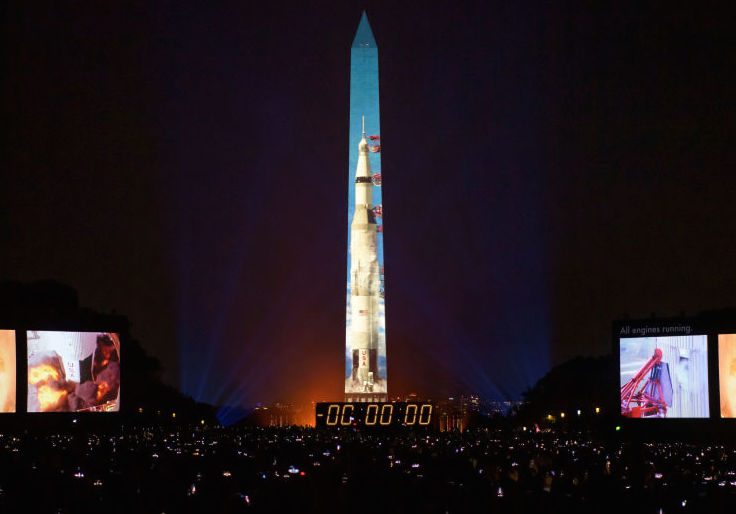Of all the people to crap on John F. Kennedy's legacy, you'd think it wouldn't be the New York Times and the Washington Post. But both papers made waves last week by commemorating the lunar landing—inspired by the martyred president's famous promise—with pieces lamenting NASA's failure to equally represent women and ethnic minorities. Indeed, the Times argued, our nostalgic celebrations of victory in that contest may, in fact, be illusory: What if the Soviets won the space race—for diversity?
I was pleased to find no such faintness of heart at the Smithsonian's Air and Space Museum and on the National Mall last weekend. A bevy of "Apollo 50" events—culminating in "Go for the Moon," a spectacular re-creation of the launch, landing, and return projected onto the Washington Monument—were enough to please the space enthusiast and fair-weather fan alike. And while rainclouds stayed away, the weather was not entirely fair—a historic heat wave hit D.C. over the weekend. Yet crowds for the projection show still almost tripled expectations.
"Go for the Moon" attracted more than 500,000 over two days, while the museum's outdoor festival and indoor exhibits, including Neil Armstrong's spacesuit, attracted tens of thousands. A night-at-the-museum event featuring a countdown to the minute (10:56 p.m. Eastern) Armstrong took his "one giant leap" attracted more than 10,000 people.
The total number of visitors to the museum last week clocked in at 70,574. "Discover the Moon Day," an educational event aimed at families, got more than 8,000 engagements on Friday, July 19.
Backing up those numbers were rave reviews from everyone I spoke to about it. My friend Michelle said it "transformed the moon landing from a date that I learned in history class to an event that gives me a sense of pride in my country and man's ability to achieve the impossible."
Another friend, Bri, said it "felt more like an actual rocket launch than an anniversary celebration. It was patriotic, simple, and genius."
You have to love Apollo's ability to turn D.C. into a hotbed of patriotic fervor. Just a couple weeks ago, the media were taking a July 4th celebration led by—gasp—the president as a sign of creeping fascism. When his "Salute to America" turned out to be awesome and his speech focused completely on America's history of achievement, not on politics, the media memory-holed the overhyped controversy.
Nothing Trump does can escape politics even when he attempts to. NASA and the Smithsonian, on the other hand, made the most of a perfect opportunity to provide something that eclipsed politics in D.C. NASA may not have the prestige and funding of yesteryear, but its mission still lets it partly transcend the political system in which it is embedded.
"We're the best place to work in the federal government because we have the best mission. We're expanding knowledge," one scientist told me at the outdoor festival. The evidence was all around her. The Apollo 50 festival, sponsored by Boeing and Raytheon, had everything from a moon rock to a motorized miniature Mars rover and a station for kids to build LEGO components for a giant rocket—together with a couple astronauts who came out for the event.
The entire extravaganza, like the Air and Space Museum itself, was a testament to the fact that there's nowhere better than America to pursue one's dreams.
It can seem impossible to return to the unified purpose of the Space Race era, but the truth is the country was deeply divided in the 1960s. Riots, bombings, and political strife occurred alongside the tireless efforts of the hundreds of thousands working to get us to the moon. In the 21st century, NASA and the Space Force will need all the talent they can get to give us the edge over China's increasingly imperialist ambitions in space. That requires a new generation of scientists and engineers turning their eyes toward the stars and believing in the American experiment, even as political discord is sure to continue.
Young people growing up probably aren't thinking about any of that. But if they're thinking about how cool space tech is and are motivated to contribute to what comes next, that's probably enough. Communist China, like the USSR before it, has talked a big game but not eclipsed the United States technologically. And China, like the USSR before it, has relied on stealing tech from us while they devote resources to perpetuating a tightly controlled and innovation-stifling economy.
Where people aren't free, the best ideas don't grow. The Soviets' nods to "diversity" were propaganda. Their systemic oppression led to talent underutilization, and their space program—and, ultimately, their whole failed empire—couldn't keep pace with ours. That's how Kennedy's outrageous promise could be vindicated, and how Ronald Reagan's arms race could lead to victory in the Cold War.
Now in 2019, Americans can celebrate the greatest technological feat in history while enjoying the fruits of a free and prosperous society. Such patriotic celebrations are integral to the task of passing our blessings onto the next generation.
